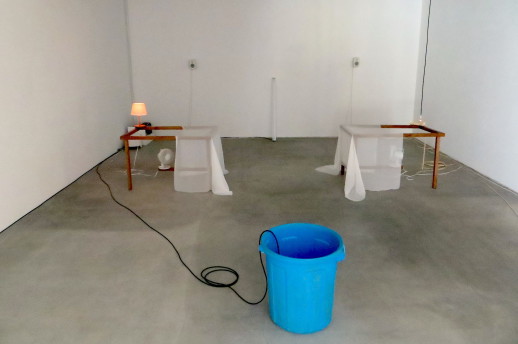Composing Chaos

As you enter the stark concrete space of Ota Fine Arts you’d be forgiven for wondering if there was even an exhibition on at all. Akin to the set of an abandoned Samuel Beckett play, a few sparse objects are scattered across the room; a table, a couple of lamps, and a trash can. Visually, the room is bare, but within a few minutes the whole place comes to life.
Suddenly the sound of footsteps fills the room. You look around, but there’s nobody there. A lamp switches itself on in one corner and a tablecloth begins to flutter. You begin to question yourself: are you triggering these events? Are there motion sensors? It soon becomes apparent that the multitude of sounds and visual cues are being programmed at random. A telephone begins to ring incessantly, while a train can be heard dimly in the distance. Was that train outside the room or part of the exhibition? Senses are becoming confused.
Born in Kyoto in 1981, Tsuyoshi Hisakado describes his latest installation Quantize (2014) as a ‘disappearing sculpture’ – sounds which are created and destroyed by the random numbers of a computer. In short: planned coincidence. Within a five-minute interval, the same composition never occurs twice, with slight changes happening all the time. Hisakado claims that he is influenced by the line, “The flowing river never stops and yet the water never stays the same” by the twelfth century Buddhist poet Kamo no Chomei.
The artist treats the room itself as his blank canvas. There’s no unnecessary visual stimuli to detract from what the artist wants you to see and hear. The sounds of the instillation merge with those of real life: your breathing, footsteps and rustling become part of the exhibition. Echoes of John Cage’s seminal piece 4’33” (1952) are evident, with the accidental sounds of real life merging with those of the artist.
This exhibition is displayed in two spaces and the other holds a mirror ball, which was exhibited at Aomori Contemporary Art Center last winter. The surface of the sphere is covered with numbers of mirrored clocks and the diffused reflections create lights and shadow which are like “riding a time-machine from the drawer of Doraemon’s desk” according to Hisakado. Unlike the previous space, which takes influence from the teachings of a traditional poet, Hisakado’s own description of his work is equally at home referencing pop culture. In this way, both old and new are represented through the exhibition.
Both spaces are complete in their own right and as such don’t quite work in harmony. But viewed separately they work with sound, light and kinetic energy, as well as redefining our idea of what sculpture should entail. The flowing river Hisakado has created is a beautiful concept and one that he executes perfectly.



